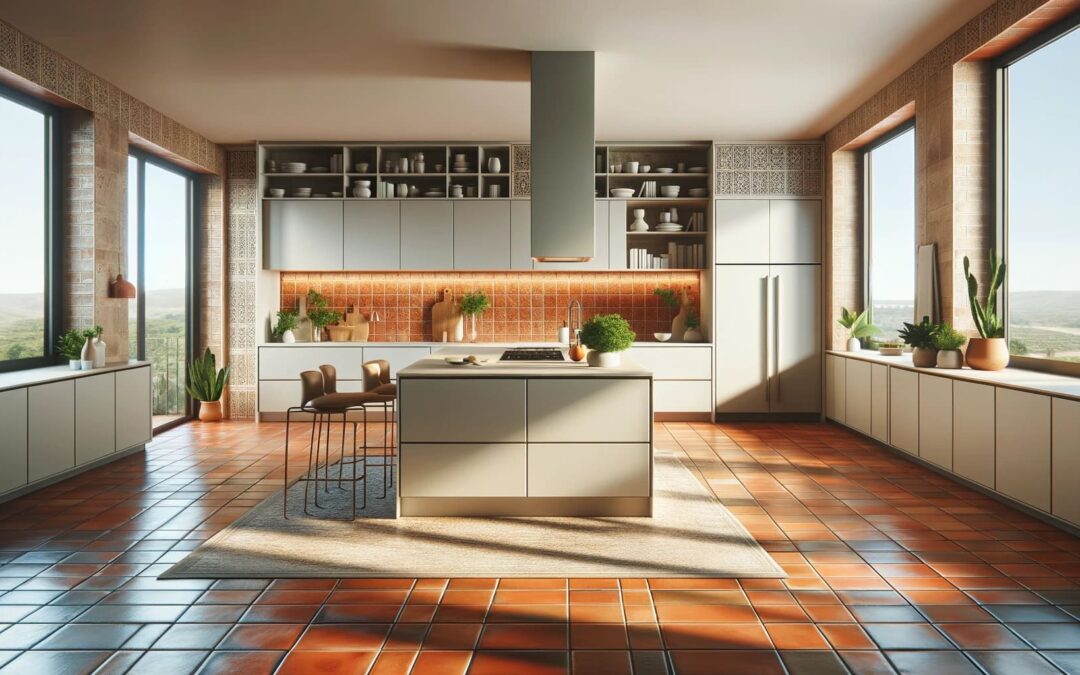Terracotta flooring has been a traditional favorite for centuries, known for its warm, earthy tones and rustic charm. In modern kitchens, terracotta can introduce a sense of timeless beauty and warmth, making it an appealing choice for homeowners seeking a blend of classic and contemporary styles. However, like any material, terracotta has its advantages and drawbacks. Understanding these can help you decide whether terracotta flooring is the right fit for your modern kitchen.
Pros of Terracotta Flooring
- Aesthetic Appeal: Terracotta tiles provide a unique, natural look that can greatly enhance the warmth and inviting atmosphere of a kitchen. Their rich, deep colors and individual character (no two tiles are exactly alike) add an element of artisanal craft to the space.
- Durability: Terracotta is known for its durability and long lifespan when properly maintained. These tiles are hard-wearing and capable of withstanding heavy foot traffic, making them suitable for the high-use environment of a kitchen.
- Natural Material: Made from clay, terracotta is an eco-friendly flooring option. It contains no harmful chemicals or toxins, making it a safe choice for homes. Additionally, its natural components contribute to a healthier indoor air quality.
- Thermal Properties: Terracotta naturally has excellent thermal properties, keeping floors cool in the summer and warm in the winter. This can help in reducing heating and cooling costs, particularly in regions with extreme weather conditions.
- Versatility in Design: While traditional terracotta tiles are known for their rustic charm, modern variations offer a range of finishes, sizes, and hues that can fit various design schemes, from the most traditional to the sleekly contemporary.
Cons of Terracotta Flooring
- Porosity: Terracotta tiles are naturally porous, which means they can absorb liquids if not sealed properly. In a kitchen, where spills are common, unsealed terracotta flooring can stain and harbor bacteria.
- Maintenance: To maintain their beauty and functionality, terracotta floors require sealing upon installation and will likely need resealing over time. This maintenance can be more demanding compared to less porous kitchen flooring options like porcelain or vinyl.
- Chipping and Cracking: While durable, terracotta is not immune to chipping and cracking. Heavy objects dropped on the surface can damage the tiles. Also, improper installation or fluctuations in temperature can lead to cracking over time.
- Cold and Hard Surface: Terracotta tiles can be hard underfoot, which might be uncomfortable when standing for long periods. They can also be quite cold in cooler weather, although this can be mitigated with underfloor heating systems.
- Consistency in Appearance: For those who prefer a perfectly uniform look, terracotta might not be the ideal choice. The natural variations in color and texture between tiles can lead to an inconsistent appearance that might not suit every taste or design style.
Conclusion
Terracotta flooring in a modern kitchen can bring a delightful balance of warmth and style to your home. Providing a durable and eco-friendly surface with lots of character. However, the need for regular maintenance and the potential for damage must be considered. Weighing these pros and cons in the context of your lifestyle and design preferences will help you make an informed decision that enhances the beauty and functionality of your kitchen. Whether you embrace its rustic charm or opt for a more refined version, terracotta can be a distinctive feature in your modern kitchen design.

